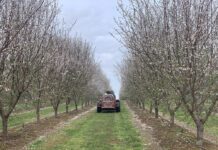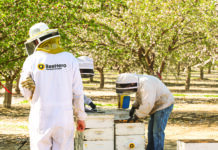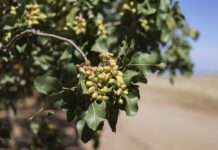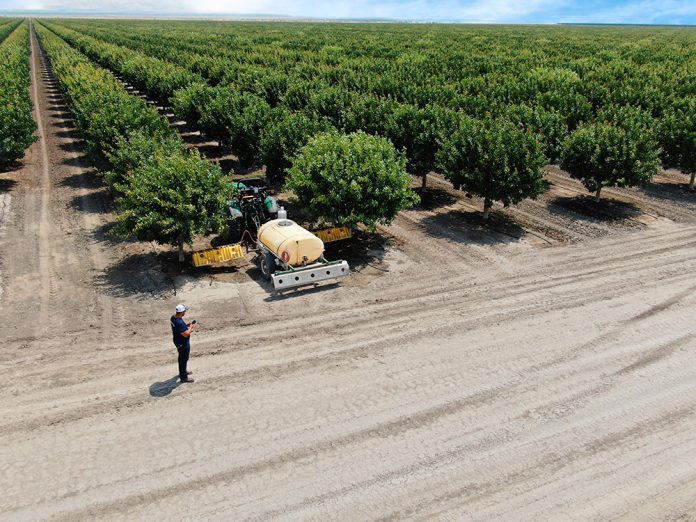
It’s not just about ‘more crop per drop.’ Technology trends related to agricultural management presenting opportunities to save on labor and crop inputs, meet regulatory requirements and increase crop quality.
Across the California tree nut industry, farming operations have changed in the past few decades, primarily due to advancements in technology including sensors, machinery and information technology. Robots, temperature and moisture sensors, infrared aerial images and global positioning systems save time and money while producing higher yields and peace of mind.
Use of new technologies allows precision application of water, fertilizers and pesticides across orchards and fields. Automated systems can direct application amounts in specific parts of fields or orchards. Advantages can include labor savings, higher crop productivity, decreased use of water, fertilizer and pesticides, reduced environmental impact and labor safety. In addition, robotic technologies enable more reliable monitoring and management of natural resources such as air and water quality. Adopting new technologies also gives growers greater control over production, processing, distribution and storage.
1. Precision Agriculture
Alireza Pourreza, UCCE researcher in biological and agricultural engineering, said use of precision agriculture tools can provide real-time data on soil moisture levels, nutrient content and pest infestations in the context of nut production. This information helps growers and farm managers make informed decisions regarding irrigation, fertilization and pest control, leading to improved crop yields and resource efficiency.
Pourreza said one crucial aspect is the precise application of nutrients and irrigation, which improves yields and protects the environment’s quality while minimizing waste. Precision agriculture benefits the environment and enhances the nut industry’s profitability and sustainability by optimizing resource utilization and minimizing environmental impact. He noted growers can reduce costs associated with excessive fertilizer and water use, minimize chemical inputs and optimize the health and productivity of their nut trees.
Remote sensing technologies, he added, such as spectral imaging and LiDAR (Light Detection and Ranging), enable the detailed assessment of crop health and productivity from a distance. These technologies can detect early signs of nutrient deficiencies, disease outbreaks, or water stress in nut orchards. Farmers can proactively address these issues before they significantly impact crop yield, resulting in higher-quality nuts and increased profitability.
Water Management and Irrigation
Tom Devol, senior manager of field outreach and education at Almond Board of California, said huge strides have been made in irrigation technology in terms of when to irrigate and for how long. Adoption of automation, Devol stressed, will push water management to the next level. Irrigation systems that need to be manually turned off and on lose the exactness of water application prescribed by estimates of ET, soil moisture sensors or multispectral imagery.
“We need to embrace automation. Do we have the ability to do this?” Devol asked. Integrating automation into an irrigation system is perceived as expensive, he said, but when you factor in the costs of labor and the benefits of saving water and pumping costs, there are cost savings.
There is also the perception that automation is complicated. This technology may not fit in all operations, Devol said, but many growers have tried it and found it works for them.
Devol said irrigating to crops’ needs is important, and an automated system can achieve that goal if vendors and growers work together and irrigators are trained in system operation.
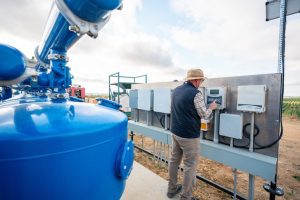
3. Genetic Advances and Disease Management
Almond Board of California and other commodity groups are funding research into genomics assisted breeding. This technology can streamline the process of developing new plant varieties and rootstocks meant to deal with pest and disease management or environmental factors.
Josette Lewis, chief scientific officer at ABC, said molecular markers are being used in breeding programs to increase the selection process. Marker assisted breeding can reduce the time it takes to select for desired traits. In the 2022 ABC Research Update, UC Davis researcher Gina Sidell noted that Exhome sequencing is one molecular breeding tool used to identify variants in a population, particularly traits that are significant but less common. These tools can be combined to make genomic predictions, forecasting phenotypes from breeding crosses based on marker effects, genetic relationship and performance for a trait.
Lewis explained that molecular markers in plant DNA are linked to specific plant traits in varieties and rootstocks. An example is the molecular marker associated with shell closure in almonds as less closed shell promotes navel orangeworm access. The value in speeding up the process of identifying the best crosses is that the seedlings can be tested to determine if they carry the specific marker desired.
Lewis said there has also been investment in gene editing, a technique that makes precision changes in natural occurring genes. That technology is not yet available, and Lewis noted it is not genetic modification. It may also not be allowed in exports to some countries.
Use of molecular markers for breeding resistance to diseases is complicated, Tom Gradziel, UC Davis geneticist, said. When breeding for disease resistance, if each variety of the cross is known to have a resistance gene for the targeted disease, that is simple. He said when multiple genes are involved, that is where molecular markers are a valuable tool for selecting genetic material. He said plant breeders’ understanding of how diseases develop and use of combinations of genetic material will be the future for disease control.

4. Data Analytics and Decision Support Systems
Great decision support systems should provide informing data and analytics that predominantly support communication between extension, advisors and producers by providing a shared understanding of what is happening at an industry, regional or farm level, according to Jordan Hazell, research manager at Semios. These support systems can take the form of a platform, offering field-level instrumentation, providing a set of data that help growers and advisors form a shared context and understanding around which they are basing their field-level decisions. These types of systems are particularly valuable, Hazell said, as they enable producers and advisors to gain access to regional disease and pest forecasting by functioning as a community. An example of this would be regional navel orangeworm pressure reports that summarize regional trapping data which advisors and producers can use to achieve more effective and efficient management plans.
These systems can also help applicators adhere to climate-based regulations and restrictions and stay compliant in an economically efficient manner. Hazell said an example is how a decision support systems can provide weather forecasts that are important when following label guidelines and minimizing risks to the crop. Ultimately this data can support applicators to more effectively plan and minimize downtime during busy production periods.
Hazell said these systems also allow for a greater return of development funding invested into research solutions for key agriculture issues.
5. Robotics and Automation
Control over orchard operations, replacing field workers with technicians and securing better information for improved decision making are realities with advances in robotics.
Luke Hemphill, director of partnerships with Fresno-based Bluewhite, said the value of robotic systems is in precision. Autonomous tractors and spray rigs do exactly what the system’s algorithm tells it to do based on planning. Adding a layer of camera, navigation and LIDAR, a series of lasers that create a clear picture of the operating zone, provides the remote operator with all the information needed to oversee the orchard task. The camera and LIDAR are also programmed to recognize specific shapes and to take necessary actions if those objects are in proximity or in its path of operations.
Pesticide and herbicide applications, mowing and other sanitation work can all be carried out by one operator and multiple machines operated remotely. Hemphill said the system developed by BlueWhite can be installed on existing tractors.
The farm implements operated remotely do not just carry out a task; they also provide feedback and data to help the grower make decisions in the future. “They can report excessive vibration or issues with nozzles on a sprayer before a human operator will know it,” Hemphill said.
Grower interest in robotic technology starts with a conversation about not being able to find enough drivers, Hemphill said. But it goes beyond that to confidence that what needs to be done today in the orchard will happen without the element of human error.
“This technology gives growers control and visibility into daily operations. It helps build resilience on farms, connecting machinery that carries out specific tasks when needed and with predictable accuracy.
“All this helps growers make better decisions,” Hemphill said.

Cecilia Parsons | Associate Editor
Cecilia Parsons has lived in the Central Valley community of Ducor since 1976, covering agriculture for numerous agricultural publications over the years. She has found and nurtured many wonderful and helpful contacts in the ag community, including the UCCE advisors, allowing for news coverage that focuses on the basics of food production.
She is always on the search for new ag topics that can help growers and processors in the San Joaquin Valley improve their bottom line.
In her free time, Cecilia rides her horse, Holly in ranch versatility shows and raises registered Shetland sheep which she exhibits at county and state fairs during the summer.







